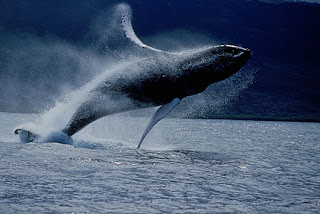True Wild Life | Humpback Whale | The humpback whale is one of the bigger species of whale with the average adult humpback whale measuring more than 15m long (thats still about half the size of the blue whale). Humpback whales are found in all of the main oceans worldwide, but the humpback whales tend to stay in three main herds, the Atlantic, the Pacific and the Indian Ocean herds. There were once thought to be less than 15,000 humpback whale individuals left in the wild, with the humpback whale population declining by nearly 90% when whale hunting became popular with humans, meaning that the humpback whale was on the verge of extinction. Since new whaling laws have been put into place the humpback whale population has been allowed to grow again and today there are believed to be roughly 80,000 humpback whale individuals left in the wild.
The humpback whales spend the summer months in the colder, polar waters and then the humpback whales migrate south in the winter to the warmer tropical waters where the humpback whales live off their fat reserves until they migrate north again in the summer. The average humpback whale can travel to around 25,000 km every year when the humpback whale migrates between the north and the south. Humpback whale mothers tend to give birth to their young during the winter months when the humpback whales are in the warmer, southern waters. The humpback whale mother feeds her calf on the milk that she produces but this means that the humpback mother is often very week when she returns to the colder, northern waters in the summer as the humpback whale mother often will not have eaten since the migration south months before.
The humpback whale is a species of Baleen whale and is thought to be closely related to the blue whale and the minke whale. As the humpback whale is a type of Baleen whale, this means that the humpback whale has rows of plates in the enormous mouth of the humpback whale, which the humpback whale uses to filter small particles of food out of the water. The humpback whale therefore does not have teeth. Humpback whales primarily feed off krill and plankton that are present in their billions in richer waters. The humpback whale will also eat small fish and crabs that get taken into the vast mouth of the humpback whale when the humpback whale is filtering large amounts of water in order to extract the nutrients from it.
The humpback whale has not one but two blow holes, which are located on the top of the humpback whales head. The blow holes of the humpback whale enable the humpback whale to breathe in air on the surface of the water. Humpback whales spout (breathe) around 1-2 times per minute when the humpback whale is resting, and 4-8 times per minutes after the humpback whale has made a deep dive into the ocean. The blow of the humpback whale is a double stream of spray that rises between 3 and 4 meters into the air above the surface of the water.
Humpback whales are often seen migrating together in large pods but the relationships between groups of humpback whales are thought to be temporary and only last for a number of days. Humpback whales are also highly acrobatic animals and are often a favourite with whale watchers as the humpback whales can launch themselves high above the surface of the water.





1 comment:
One of the bigger whale. Is humpback whale a fish or mammalia?
Post a Comment